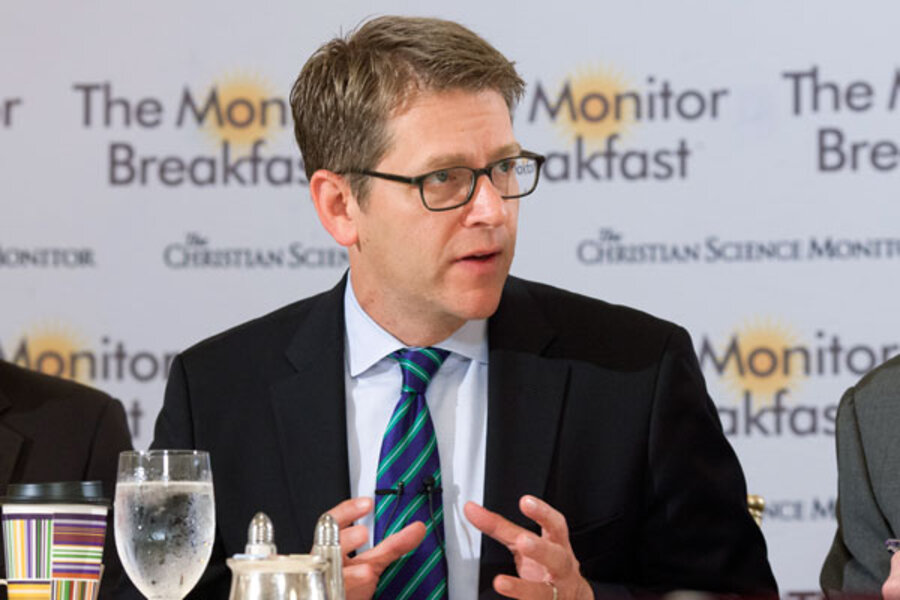Jay Carney, departing Obama press secretary, pulls back White House curtain
Loading...
| Washington
For 3-1/2 years, Jay Carney was the bespectacled, youthful-looking man on the podium, taking incoming from an information-hungry White House press corps.
Now his tour as President Obama’s press secretary is over, and at a breakfast with reporters Thursday hosted by The Christian Science Monitor, Mr. Carney peeled back the curtain a bit. What most surprised him? What did he learn? How has the rapidly changing media landscape affected policy and politics?
“What is surprising is how human the enterprise is, how small the rooms are, how in the end, very weighty decisions are made in a very human way,” Carney said.
As a former White House correspondent for Time magazine, Carney came in with a sense of how things worked that wasn’t quite right, he says. White House reporters, including his former self, “make assumptions about control and process and intent” that don’t account for the reality: that “a lot of these issues have to be decided … by a handful of people sitting in a room who are dealing with the best collection of facts that they might be able to get.”
But invariably, Carney adds, the collection of facts is incomplete and the environment challenging. Usually, by the time an issue reaches the Oval Office, “you don’t have the luxury” of having the option that says, “You get everything you want.”
The other side of that, he adds, is that “the people in that room are trying to do the right thing as they see it.… I was very encouraged by what I saw from the very beginning, people dealing with, especially beginning with economic collapse and through to this day, with really, really tough issues and trying to get it right, in a way that they thought best served the country and its people.”
“That sounds a little mooshy,” Carney said, “but it is encouraging, because I think there is a tendency, and I again succumbed to it, to be very cynical about the decisionmaking process, very cynical about what the reasoning behind anything that a White House does is.”
“There’s a tendency to assume that politics and political considerations drive every decision,” Carney says. “And I’m here to tell you that’s definitely not the case. I’m here to tell you, as somebody on the communications political side, it would have been a lot more convenient had it been the case, in some ways. But it’s just not. And that’s I think for the country a good thing.”
Was there a tension between his “old self” – the news reporter and analyst – and his “newer self” as a spokesman, where the job was perhaps to “spin,” or as former Clinton White House press secretary Mike McCurry put it, “telling the truth slowly”?
Carney says he benefited greatly from spending his first two years in the Obama White House working as communications director for Vice President Joe Biden, a behind-the-scenes job.
“When I got in there … I was shocked to find out how the expertise I felt I had developed as a political reporter about communications strategies and White House communications was not really expertise, and there was a lot to learn,” says Carney. One of his teachers was former top Obama adviser David Axelrod, himself a former newspaper reporter.
“I felt liberated,” Carney said, no longer having to avoid taking sides on issues.
Carney also experienced the dramatic changes in the media landscape from a unique vantage point – inside the White House pressure cooker. Since Obama has taken office, social media have flourished as a force for both gathering information and disseminating it. Media outlets that barely existed, or didn’t exist at all, are now central to the daily conversation.
From the perspective of White House communications, these changes force assessments – made “very quickly” – about “whether or not we need to chase that ball down the field or we should take a step back and wait and see where something is going that’s just popping in Twitter or elsewhere.”
There’s often an urge to respond “instantly and aggressively,” Carney says. But “there is some wisdom in being discerning about doing that, because Twitter and social media have created an environment where new news grabs people’s attentions here much more quickly than it used to.”
“The fires burn brighter than they used to,” he says, “but they burn out faster.”








